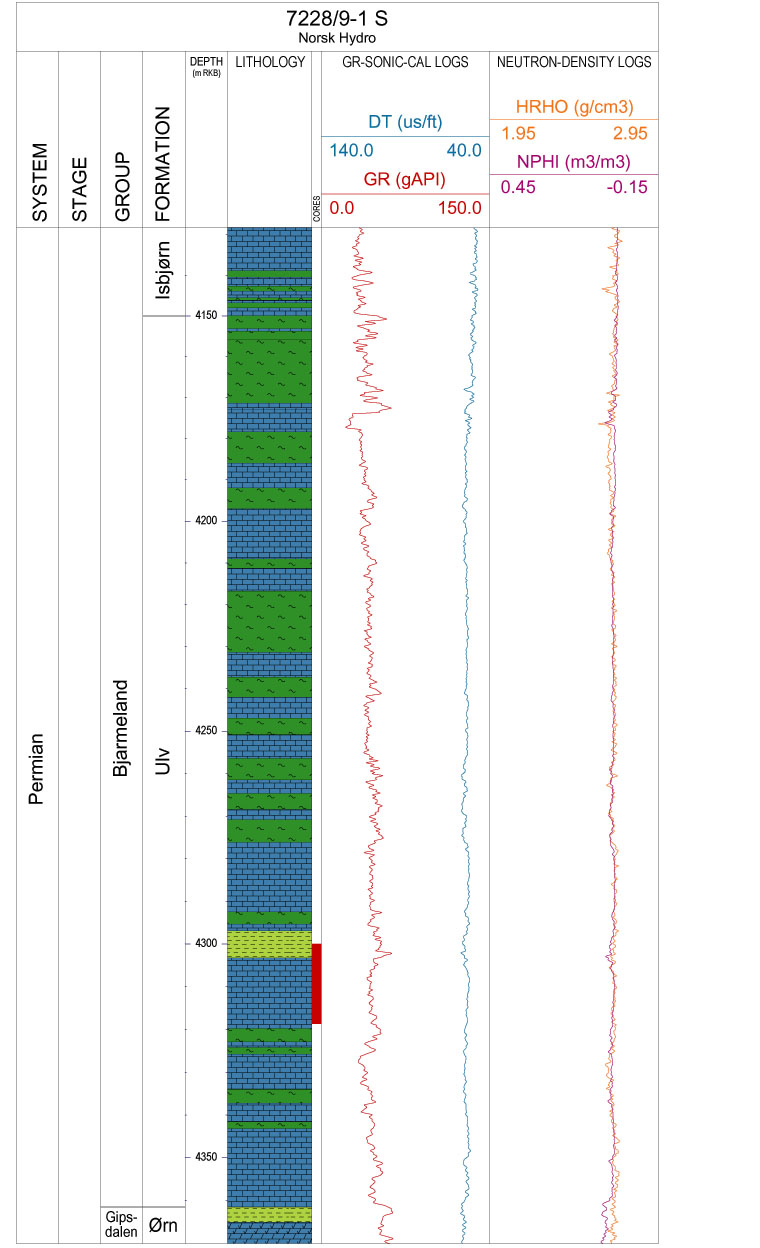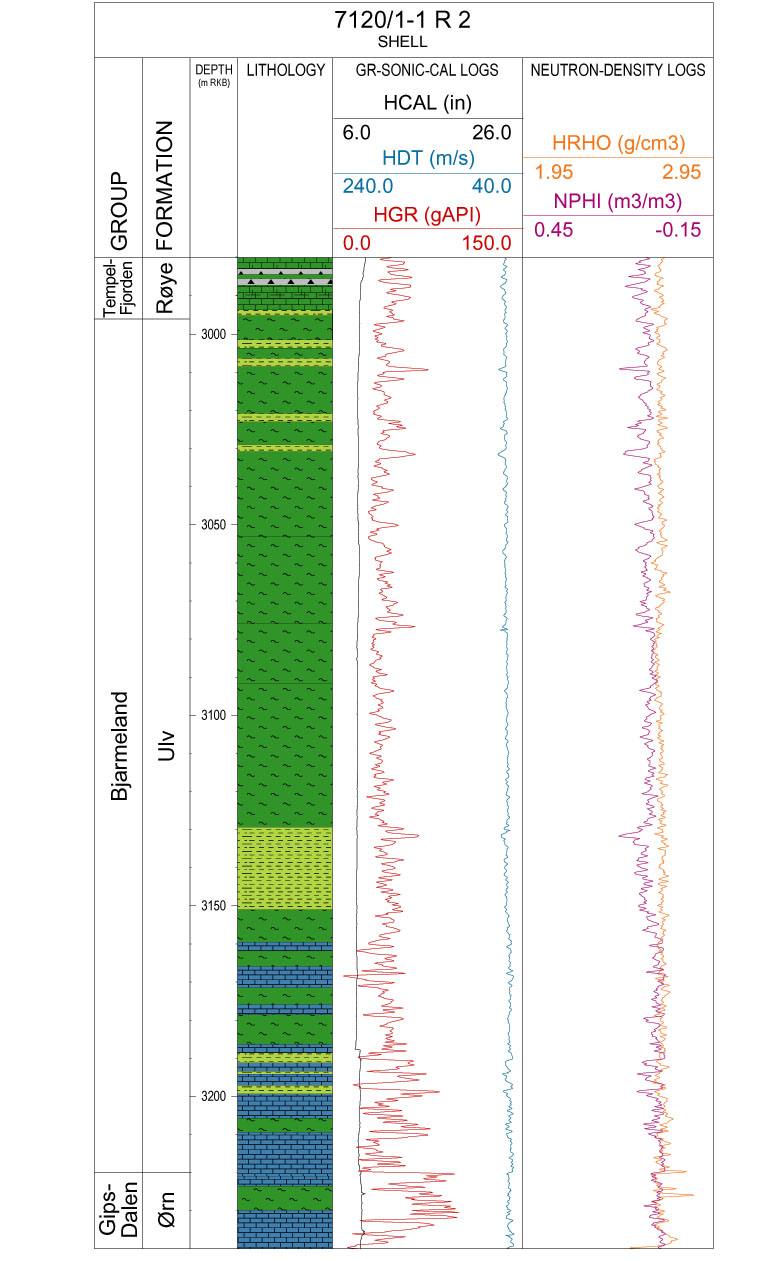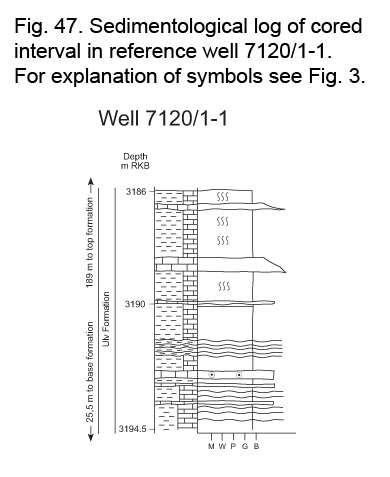 |
|
 |
|
From the Norwegian name for the Wolf (Canis lupus).
The type section is defined as the interval from 4361 m to 4150 m in well 7228/9-1S on the margin of the Finnmark Platform towards the Nordkapp Basin (Fig. 45; Table 1). One core exists from the lower part, between 4300 m and 4319 m. The base is taken at the first significant and relatively sharp decrease in gamma ray response above the higher gamma ray readings of the underlying Gipsdalen Group (Fig. 39). This is associated with a marked decrease in the neutron porosity log, resulting in a very low separation between the neutron and the bulk density logs. There is also an accompanying decrease in interval transit time.
Fig. 45. Well logs of the type section of the Ulv Formation in 7228/9-1.
For explanation of symbols see Fig. 3.

Well reference sections:
Reference sections are found in the intervals from 3220 m to 2997 m in well 7120/1-1 on the Loppa High (Fig. 46; Table 1) and from 4182 m to 4103 m in well 7226/11-1 on the Bjarmeland Platform (Fig. 41). One core exists from the lower part of the formation in 7120/1-1, between 3185 and 3195,5 m (Fig. 47).
In wells 7121/1-1, 7124/3-1 and 7226/11-1, the lower boundary is marked by an increase in gamma ray values reflecting the transition from cleaner limestones (of the underlying IsbjГёrn Formation in the first two of these wells and of the Polarrev Formation in the third) up into more silty limestones (Fig. 39).
Fig. 46. Well logs through the reference section of the Ulv Formation in Well 7120/1-1.
For explanation of symbols see Fig. 3.


The formation is more than 210 m thick in wells 7120/1-1 and 7228/9-1, thinning to 80 m in 7226/11-1 and to less than 60 m in 7121/1-1 and 7124/3-1. The formation is not developed in wells 7128/4-1, 7128/6-1, 7228/9-1 and 7228/11-1 on the Finnmark Platform.
Dark fine-grained bioclastic limestones dominate the formation. The dominant microfacies are bryozoan-crinoidal wackestones and more rarely packstones. Additional faunal elements include siliceous sponges, brachiopods and rare fusulinids. The limestone is thinly bedded and often contains thin silt laminae. Shales and silty limestones are locally abundant and chert nodules occur locally. The formation includes thin, less than 15 m, units of coarser grained bioclastic limestone that lithologically resemble the overlying Isbjørn Formation’s dominant lithologies.
The formation represents deposition in relatively deep water and is not developed on most of the Finnmark Platform. It is believed to be widespread in the distal parts of the platforms, between the Polarrev Formation buildups, and in deeper basinal areas during deposition of the lower part of the Bjarmeland Group. Later in the group’s development, the formation appears to have been more widespread, although mainly restricted to outer platform and basinal areas. Landward it interfingers with coarse-grained bioclastic grainstones typical of the Isbjørn Formation.
Fusulinids suggest a mid-Sakmarian to Artinskian age (Davydov 2000).
Deposition took place in relatively deep shelf environments below storm wave base. More clean limestone intervals reflect either reworking of material from the shallower cool-water carbonate platforms or from adjacent buildups. Siliciclastic input was limited in the eastern part of the region but seems to be more significant along the western margin of the Loppa High. This suggests syndepositional tectonic instability along the crestal part of the Loppa High.
The formation is not known from the onshore areas of Spitsbergen or BjГёrnГёya, but lateral correlatives may be represented by the interdidal/supratidal dolomites of the Skansdalen, Templet and SГёrfonna members uppermost in the Gipsdalen Formation of Spitsbergen and Nordaustlandet.